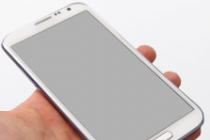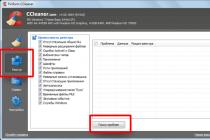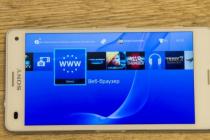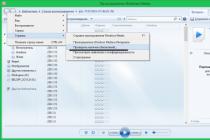Mobile phones were the first to hit the market. At first they had a very impressive size, but as microelectronic technology improved, they became more compact and convenient. Nevertheless, their main functions have practically not changed - the main purpose of cell phones and now is the implementation of telephone conversations, sending and receiving SMS and MMS.
But the development of technologies does not stand still, so phone manufacturers began to endow them with new properties. In particular, they made it possible to use cell phones for games and Internet access. This set of functions can now be considered basic, it is present in almost all models mobile phones.
Further improvement of phones faced manufacturers with a serious problem: the more custom programs, the more difficult it was to adapt them to a specific "hardware" - that is, the hardware stuffing of the phone. An operating system was needed that would remove such restrictions and allow applications to run on different models phones.
Java was the forerunner of mobile operating systems, but it had significant drawbacks. In particular, it was not possible to run more than one application at the same time. The result of the efforts of the developers was the emergence of mobile devices with a fully functional operating system, such phones were called smartphones, which in English means “smart phone”.
What is the difference between a smartphone and a communicator? A smartphone is a cell phone that has operating system and endowed with a wide variety of functions. A communicator is, first of all, a pocket computer, in which the communication function is additional, but not the main one. In general, we can say that as technology develops, the border between smartphones and communicators is gradually blurring.
Speaking of smartphones, one cannot fail to mention the famous iPhones released by Apple... Thanks to its exclusively high quality and very great opportunities, iPhones have become the flagship of the smartphone market. The name, iPhone, indicates that the device uses the iOS operating system developed by Apple. Other manufacturers usually use Android operating systems and Windows Mobile.
What capabilities do smartphones have? First of all, they are focused on working with the Internet. Their owners can view sites, communicate in social networks, watch movies and listen to music, play a variety of games, use thousands of mobile applications.
Hello dear blog readers!
First of all, I am very glad to welcome you to the new design of my resource. Long wanted to change appearance site, but that time was not enough, then opportunities. But it was impossible to delay further, so I nevertheless asked one excellent designer to remake me the appearance of the blog (or, more precisely, to do it from scratch, but leaving the main advantages of the old design).
How do you feel about the new design? Did you like it? Is it better than the previous one? Do you have any ideas for improving it? I would be very happy if you answer any of these questions in the comments to this article.
Now let's go directly to the topic of the post. As you know, in my article on video games, I promised that I would continue to write about innovation, technology and everything that the 21st century has to offer us.
I keep this promise, and today I will tell you about what has already become an integral part of the life of everyone who acquired it. I'm talking about IT devices like smartphone, tablet, laptop, eBook other.
This series of articles, rather, will be useful to people who have long intended to purchase one of these devices, but find it difficult to choose one. And I fully understand them, because the question is not about tens, and not even about hundreds of rubles, and therefore I would not want to give a significant amount and get a low-quality product or one that does not meet expectations or is not useful.
At one time, I spent more than one and not 5 hours studying this issue, and found that, as in the case of video games, I am dealing with a whole industry. There is just a huge number of manufacturers, operating systems, there is a classification of devices and much, much more. This series of articles is being written to save you time by sharing my experience in researching this issue and testing and using these devices directly.
So, the guest of our day is a smartphone.

Smartphone(from the English smart - smart, phone - phone) is a mobile phone we all know, but it has evolved into something more. What exactly? I won't be mistaken if I say that it is a real PDA (compact personal computer). As in the case of a computer, it has its own operating system (we'll talk about them a little later), on which applications are installed. This allows the smartphone to go far beyond the "dialer" functionality.
Manufacturers often install different sensors in their next product: accelerometers, compasses, gyroscopes, etc. Combined with different applications, this allows you to determine your location and navigate on the map, determine the slopes of surfaces and more. Also, there is a music player, video player and internet browser.

A distinctive feature of a smartphone from a mobile phone is the presence of a large touch screen. The absence of buttons allows you to increase the display area of visual information, which, of course, is a convenient solution when using - it is more convenient to watch videos, browse Internet pages, and many other operations are easier to perform.
Separately, I will say about the touch screen: it is much more convenient and easier to use it when navigating the same Internet pages or even through the device menu than using a numeric keypad and a joystick (crosshairs). This is especially true when typing.

Based on my experience, I can say this: don't be fooled by the great functionality of your smartphone! Believe me, 60% of those who bought a smart phone use it to make a call, write an SMS and see the time. This is despite the fact that the same functions are performed by an ordinary mobile phone, which is 2-3 times cheaper.
The other 30-35% of people initially used their smartphone to the maximum, but then came to the conclusion that a heavy load drains the battery faster, and 80% of functions are absolutely useless. Now they call from it, go to the Internet, use notes and reminders, maybe an alarm clock and (very rarely) a stopwatch. An average device is suitable for such functionality. price category- 7-15 thousand rubles (and often a budget one - up to 7 thousand - is very suitable), but the owners of flagships - 15 thousand and more - are very often disappointed in their acquisitions.

So, let's summarize a small summary of the smartphone.
pros:
- good old dialer, a means of communication, without which there is now nowhere;
- the ability to access the Internet anywhere in the Wi-Fi zone or mobile network coverage;
- a large number of small functions with which a smartphone collects the functionality of a bunch of different tools (notepad, stopwatch, ruler, calendar, etc.);
- is an accessory that speaks of your image (the more expensive the smartphone, the higher the image, but in any case, even with a budget smart, you will look more solid than with a dialer with buttons. Why? Well, this is how society is already talking ...).
Minuses:
- functionality quickly becomes boring, which is why most devices cease to justify their cost;
- Wi-Fi is not available everywhere, and 3G Internet is often an expensive pleasure;
- without the ability to access the Internet, it has only slightly more functionality than a regular mobile phone;
- unlike the same mobile phones, the smartphone requires recharging, on average, every 2 days.
Output: in my personal opinion, the advantages of a smartphone are more weighty than the disadvantages, which means that wisely chosen smart will become a useful tool and accessory for you in your life and work.
Now let's take a look, but how do you choose a smartphone “wisely”?
The first thing to choose is the operating system. There are three main ones: Android, Windows Phone and iOS.
The first one is Android - the most popular, let's start with it. The development and support of this OS is handled by the well-known Google... It is installed on devices from most manufacturers. The most famous android smartphones are smartphones from Samsung, HTC, LG, ASUS, Sony and many other manufacturers.

The advantage and at the same time the disadvantage of this OS is its openness and freedom of customization. You yourself are free to choose the interface of your gadget (often, the manufacturer's shell is installed by default, but this does not prevent you from replacing it without getting into program code smartphone). Also, you yourself install the applications you need, and with via USB can open a directory of files and folders without any additional services and programs.
Why is this an advantage? Because it is easy and affordable to customize the smartphone for yourself and your needs. Why disadvantage? Because such a setting requires learning and mastering, and also such freedom makes it possible to "screw up" in the settings so that you have to carry your brand new smart to the SC. In short, android is an operating system for the thinking and not lazy. And it scares some (I wonder why? ..).
Further, Windows Phone- the operating system of the Microsoft company. Yes, yes, this is the same Windows familiar to us, but adapted for mobile devices. At the moment, only Microsoft itself produces devices under this operating system, although you can still find models from Nokia on the market (rarely from HTC and Samsung).

All smartphones under this OS have a template interface, and change it simple user it is forbidden. While this is not pleading with the fact that Windows Phone is beautiful and easy to use. In addition, developers place great emphasis on speed and simplicity. And although there is much less freedom here than in android, it is pleasant and comfortable to use such a gadget. Also, synchronization with a PC using the Zune program is well organized (although you cannot directly connect to directories).
This operating system is quite young, and therefore many complain about the relatively small number of applications. However, the store Windows Store grows and develops, every day there are applications that are analogous to those found on other OS, as well as absolutely unique. Therefore, the scale of this problem is gradually decreasing.
As a conclusion, I can say that Windows Phone is an excellent operating system with a lot of development potential. In addition, WP devices are significantly cheaper than their android counterparts with the same quality level. Windows Phone is worth it if you like Windows Phone. If you like its interface, if speed and simplicity are important to you, and all this for a reasonable price - Windows Phone will not disappoint you.
And the latest operating system - iOS... Everyone already knows which company produces this OS and on which smartphones it installs it, right? And everyone knows very well how much such devices cost. Due to the fact that they are definitely and definitely not worth their money, that the aforementioned company invests half of the cost of its products in its brand (the same stub), I will not tell you anything about iOS.

Interesting? Enter into Google "review on the IPhone 6" and see how everyone loves this "product". My opinion is this: I took the cost of the sixth iPhone, bought a smart one from Microsoft, and invested the rest in the Internet or self-development. Seriously, it is better to buy an e-book for the rest (there will be a separate article about them).
Okay, we've decided on the operating system, now choose a manufacturer... With WP, everything is clear, but there are a lot of "androids", eyes run up.

I will tell you this - here is a delicate moment, brand manufacturers - Samsung, HTC, Sony and LG - also invest in the brand value, but these guys know their job. Here you will receive a well-assembled and thoroughly tested product that, if used properly, will last you a minimum of 2-3 warranty periods.
Other, less eminent manufacturers - Prestigio, ASUS, ZTE and others - their brand costs less, but this does not mean at all that they make lower-quality gadgets (although sometimes this is the case). In order to be competitive, they produce products that are not worse, and often even better than the aforementioned branded devices. But the risk of getting a pig in a poke is still present.
Now let's talk about the price... As I said, flagships do not always justify their cost, so do not follow the stereotype “more expensive is better”. Look closely to the middle-class and budget models, they are quite capable of satisfying all the needs of 80-90% of potential buyers, without taking away extra cost from them.

And finally, here's my advice to you: after weeding out all smartphones according to this principle and choosing one or several that suit you, do not rush to buy them at breakneck speed. Take an hour or two to look at or read a couple of reviews about them, a few reviews and recommendations. Treat this wisely and then you will choose the one you need, and it will become your irreplaceable assistant in your business.
What is the difference between a smartphone and an android? - this question can often be heard from those who are not versed in technology and want to buy a new phone.
Smartphone- a phone with advanced functions compared to regular phone... On it you can download applications, take photos, surf the Internet and much more.
Android Is an operating system for technology of various categories, including tablets and smartphones.
Based on the definitions above, it is clear that the question is not entirely correct, since a smartphone is mobile device and android is the operating system. Therefore, it would be more correct to put the question in this way - how does a smartphone on Android OS differ from other devices.
Benefits of a smartphone on android
Google is a proven company, so don't worry about cheating and leaking files - everything is reliable.
Other popular operating systems

Such an OS will be relevant for those who actively use Microsoft products. Otherwise, the user will not notice any special advantages for himself.
Which is better to choose
iOSandAndroid are leaders among other systems and are in constant competition. If Android synchronizes with google, then iOS has its own cloud, that is, it does not need synchronization with any other services.
In addition to those who consciously love and settle for Android, there are also a large number of those who have no choice. Prices for iPhones have always been significantly higher than for smartphones.
Each OS has its own nuances, but whatever you choose - android or iOS, you will in any case get high-quality work from the leaders among operating systems.
Now the word "smartphone" will surprise no one. Even if you do not possess it, then at least once, but have heard it and roughly know what it means!
But that's the point, and that's about it. Not everyone knows exactly what the word smartphone means, how it appeared and how this gadget differs from a phone, communicator or PDA. Let's try to figure it all out together.
The meaning of the term Smartphone
Russian language in our time is full of foreign words. AND this term not an exception.
The word Smartphone comes from the English Smartphone, which, in turn, combines two words:
Smart- means "smart"
Phone- means "telephone".
Thus, we can conclude that Smartphone Is a phone that has “smart” functions of a mobile computer: both computing (processor, RAM, ROM) and communication (WiFi, 4g / LTE, Bluetooth, GPS, GLONASS).
And then what is called the Communicator ?!
Do not forget about the synonym word - Communicator. The fact is that in their meaning, both terms are actually the same thing. The confusion appeared here again thanks to the manufacturers. And that's why! At that time there were no tablets, and instead of them on the market there were PDAs - a pocket personal computer. At its core, it was a small tablet on the Windows Mobile operating system. Despite the fact that he had a touch screen, it was impossible to control the gadget as it is now, with the help of a finger. For these purposes, a special stylus was used, similar to ballpoint pen(By the way, until recently he still met at Samsung Galaxy Note).
And what the manufacturer considered his brainchild depended on what he called it. If the developers thought it was a phone with PDA functions, it was a “Smartphone”. If they positioned it as a PDA with telephone functions, then it is a "Communicator".
Of course, now, when the very concept of "Pocket Personal Computer" has simply disappeared, as well as the devices themselves representing this class, then the semantic difference between the two names of the same apparatus has disappeared.
There was one more variant of classification according to the operating system installed on the device. It so happened that if the operating system is installed Microsoft Windows Mobile or PalmOS- then this is a communicator, but if the gadget is controlled Symbian OS, then this is already a smartphone. Of course, now, after a while, such a division seems strange and ridiculous, but then, in the early 2000s, it was like that. The funny thing is that the appearance of the Android and iOS operating systems practically nullified their predecessors. Palm OS and Symbian have practically sunk into oblivion, and Windows Mobile has transformed into Windows Phone.
Mobile operating systems
At the moment, there are 10 main mobile operating systems that have been the most popular over the past 15 years:
Android - iOS - Windows Phone (Mobile, CE) - BlackBerry - Symbian - Samsung Bada - FireFox OS - Palm OS - Web OS - Linux Ubuntu
Unfortunately, a considerable part of them are already in the past and are unlikely to receive further development. At the moment, TOP3 looks like this:
The history of the emergence of Smartphones
At the beginning of 2000, the new Ericsson R380 mobile phone appeared on the market. It was the first device that the manufacturer officially called a "smartphone" and from which the development of a whole class of mobile equipment began.
The Ericsson R380 ran on the Symbian OS mobile operating system and had a monochrome touchscreen.
A competitor, the Nokia 9210, appeared almost after him on the market.
Nokia by this time already had a whole line of communicators, but none of them was popular. They were bulky, inconvenient and not very functional. Therefore, the model 9210 was fundamentally different and, accordingly, they began to call it differently - Smartphone... That is, Nokia positioned it exactly as an advanced phone. Then a stormy development began, during which more and more new players joined the race - HTC, Sony, Motorola, Siemens. Have been tried absolutely different technologies and form factors (sliders, clamshells). The phones were equipped with a full QWERTY keyboard.
This continued until 2007, when a new trendsetter appeared on the scene - iPhone smartphone on the iOS operating system from Apple.
This keyboardless candy bar set the direction for the next decades. And a little later, its main competitor, the Android operating system, and first dozens, and then hundreds of models of smartphones on this OS, saw the light.
What is the difference between a smartphone and a mobile phone
1. Software filling. The phone has a firmware with a certain set of functions. The communicator already uses a full-fledged operating system (IOS, Android or Windows), which allows not only using the existing capabilities, but also expanding due to the installation of additional programs.
2. Hardware capabilities. Hardly anyone knows which chip and how much random access memory used on regular push-button telephone... But on modern smartphones already using multi-core processors and several gigabytes of RAM. In terms of productivity, such devices are plugged into the belt by computers older than 5-6 years.
3. Communication capabilities: availability of WiFi, 4G / LTE, GPS, GLONASS modules.
4. Additional features: Pedometer, gyroscope, IR port, USB.
5. Ability to work with different types files: audio, video, documents, tables, presentations.
6. Synchronization of data with cloud Google services, Apple, Microsoft, etc.
7. Screen size. The phone does not need a display with large diagonal... And with a high resolution, it simply will not be able to work because of the modest hardware capabilities. Smartphones and tablets have an average screen size of 5 inches.
The history of smartphones shows how human life is changing. In the 80s, people wanted to carry a communication device in their pockets, but nothing more. In those days, only children played, and their cell phone was not available. The organizer was a paper notebook, and later a separate electronic device like a calculator. A cassette player allowed listening to music on the street. Well, there was no talk of videos - they were viewed only indoors, for this a VCR was used. In a word, it is completely incomprehensible why she wanted to combine the functions of a telephone and a personal computer. But, as it turned out, this decision was correct.
But it really didn't start with the Finnish giant. Of course, his engineers were firsthand familiar with PCs - the company produced them with might and main, as you can see by reading. But the first to significantly reduce the size of the computer tried a larger player in this market - IBM. In the early 90s, there were already so-called PDAs - pocket personal computers... IBM decided to try adding communication features to this device.
I must say that cell phones in those years remained like bricks. Therefore, the product of the computer giant turned out to be very cumbersome. He was named IBM Simon presenting in 1992 at COMDEX. But then it was only a concept - the creators could not get stable work from their creation. According to their idea, the device combined a mobile phone, PDA, pager and even a fax. To control all this functionality, a monochrome touch screen was used. By the way, this allowed IBM Simon become the first touch phone in the world... Sales of the device started only in 1994, and only in the United States - to be precise, in 15 states. The cost was $ 899.
What did IBM Simon do? It had a built-in telephone and address book, calculator, notebook, calendar, world clock, Email and several games. The smart keyboard was used to enter text. You could press the screen with your finger or, which had to be purchased separately. It also supported PCMCIA. Although there wasn’t much sense in it, the device couldn’t play MP3 music or display pictures. Most importantly, it did not have an operating system to install additional applications. That is why IBM Simon should not be considered a full-fledged smartphone. He only served as inspiration for other companies.
Another interesting experiment was carried out in 1996. It was conducted by Hewlett-Packard and Nokia. The fruit of their joint labors was the CCP called 700LX... This device can be considered a redesigned version of the HP 200LX - a clamshell pocket computer equipped with a QWERTY keyboard and monochrome display. The only noticeable difference was the appearance of a special place for installation cell phone Nokia 2110... This is how the Americans “elegantly” solved the problem of lack of voice communications. Of course, such a product cannot be called a smartphone, since it consisted of two completely independent devices.




Gradually sizes of modules cellular decreased. Mobile phones are no longer a murder weapon. It's time to try to truly combine the capabilities of a PDA and a cell phone in one device. So the famous was born Nokia 9000 Communicator, it happened in August 1996. The device had a folding case, an external antenna and a comfortable QWERTY keyboard. The information was displayed on a fairly large monochrome display. The device was powered by the GEOS operating system. The dimensions of the communicator were 173 x 65 x 38 mm. The weight was equal to an impressive 397 grams. Interestingly, the device could be used even when closed - for this, there was a numeric keypad on the top panel and small screen... In the future, Nokia will use this form factor more than once. The last time we will see the same number of displays and buttons in the Nokia E90.

The disadvantage of this unusual device was the closed operating system. Finnish developers did not have time to introduce the ability to install additional applications here. But even without this, the device was not inferior to the full-fledged PDA that existed at that time. And in addition to this, it allowed making calls. That is why we can assume that it is the very first smartphone in the world, albeit with some reservations.
Interesting fact: in the future, any PDA supplemented with a GSM module will be called a communicator for a long time. By analogy with MFPs, which for a very long time have been called "copiers", although this word is a trademark owned by the company of the same name.
Development of smartphones
Later Nokia released several sequels to its communicator. From the original 9000i, 9110 and 9110i did not differ very much. Finns added the ability to access the Internet and some other functionality. But it remained clear that it was necessary to create a full-fledged operating system that would support the installation of applications from third-party developers. But even a large company Nokia could not afford it. But a solution to the problem was nevertheless found - in 1998 a consortium was founded Symbian, which will develop the operating system of the same name. In addition to Nokia itself, the consortium includes Ericsson and Psion. In the future, some other companies joined this community as well.
Before the first fruits of the consortium's labor, Nokia communicators had no competitors. Of course, interesting products came out in some markets, but for one reason or another they were not in great demand. For example, in 1999 in the United States were sold Qualcomm pdQ 800 and pdQ 1900 operating with Palm OS. But buyers were repelled by the heavy weight and high cost. Therefore, the American company soon concentrated strictly on.

In 2000, the Swedish company Ericsson decided to make its answer to Nokia communicators. She released a device with a large monochrome touchscreen and a flip cover that housed a numeric keypad. The model received the name Ericsson Smartphone R380... As you guessed, exactly this device introduced the concept of "smartphone"... He used Symbian OS 5.1 as an operating system. Here still remained impossible installation third party applications... Perhaps that is why Nokia began to use a later version of this operating system in its smartphones.
 Ericsson R380 is worthless by modern standards. The device had only 4 MB of permanent memory, of which only 1.2 MB were available to the user. The amount of RAM did not exceed 2 MB. Well, its 3.5-inch screen had a resolution of 120 x 360 pixels. The image was displayed on it in four shades of gray. Everything is in order, the device was only with a weight that was only 164 grams. They sold a smartphone for $ 700.
Ericsson R380 is worthless by modern standards. The device had only 4 MB of permanent memory, of which only 1.2 MB were available to the user. The amount of RAM did not exceed 2 MB. Well, its 3.5-inch screen had a resolution of 120 x 360 pixels. The image was displayed on it in four shades of gray. Everything is in order, the device was only with a weight that was only 164 grams. They sold a smartphone for $ 700.
The Symbian era
This is not to say that Ericsson's product is the first touchscreen smartphone... There were similar devices before him. However, it quickly became clear to everyone that touch screens were still far from ideal, and therefore they decided to abandon them for a while. The sixth, seventh and eighth versions of Symbian supported them only in theory, in practice only Ericsson devices used this opportunity (the mobile divisions of the Japanese and Swedish companies merged at that moment). The heyday of the Symbian operating system happened in the first half of the 2000s. First the communicator was born Nokia 9210... The sixth version of Symbian was used here. At the same time, the Finnish company slightly modernized the interface of the operating system, giving the platform the name Series 80. Along the way, a smartphone was presented Nokia 7650... Outwardly, it was quite simple, but on board was the Symbian OS 6.1 operating system. It finally allowed third-party software to be installed! However, the device had a drawback in the absence of a memory card slot. This imposed serious restrictions.

Well, then, as they say, off we go. Gradually they began to go off the assembly line the first smartphones that could be called mainstream... People began to understand that these devices could easily replace a regular mobile phone - now, to use a smartphone, they did not need to work as a manager or own any serious company. Also, the proliferation of devices based on Symbian contributed to the price reduction. If earlier it was possible to buy a PDA or a communicator for $ 600- $ 700, then smartphones with the Symbian operating system were sometimes sold for $ 250- $ 300. In particular, at one time were very accessible Nokia 6600, Nokia 3230 and some other models. Also, the Symbian operating system was installed on smartphones from Sony ericsson, Motorola and, but for various reasons they did not become particularly popular.

On account of Nokia and the first. It is, of course, about Nokia N-Gage... The device was based on Symbian 6.1 and this can be considered the main reason for its failure. The fact is that the operating system in those years developed at an unprecedented pace. As a result, this version became outdated very quickly - it was replaced by the "seven", and then the "eight". The device quickly became irrelevant. Contributed to low sales and some technical problems- for example, no one liked to call on such a smartphone, since for this it was necessary to put it to the ear with its end. However, this problem was eradicated in N-Gage QD.

Remembering the first smartphones, one cannot fail to mention the rulers E-Series and N-Series... Nokia realized that four-digit model names are extremely difficult to remember. Therefore, subsequently all smartphones were divided into two series. The E-series includes devices that may be needed by an office worker, a bank clerk and other serious people. Such devices could boast of a pre-installed ability to open office documents, and also with their help it was possible to make group calls. As for the N-series, it includes the so-called multimedia devices. They sounded better, they possessed the best camera, and on their bodies it was often possible to find buttons associated with controlling a music player.

Smartphones with an operating system were also popular in those days. Windows Mobile... Some of them had a touch screen and stylus, while the interface of others was adapted to operate with buttons. More actively than other similar devices were produced by a Taiwanese company. Its first smartphones were created for other companies, which then sold them under their own brand. Later, the Taiwanese began to use the Qtek trademark. And only then they switched to the HTC brand. Most of all, this manufacturer was remembered for its proprietary shell. HTC Sense... It made the interface much more beautiful, and the clock widget did not let you take your eyes off. The first smartphone with this shell became HTC Touch Diamond2... It was based on Windows Mobile. Branded shell allowed to abandon the stylus, since all the icons and menu items here turned out to be quite large. Later, the Taiwanese company began to preinstall its interface on smartphones with the Android operating system. It must be said that not least of all this contributed to their popularization. And it was the HTC Sense shell that made live wallpapers popular.
The era of iOS and Android
In 2007, there were a large number of touchscreen smartphones on store shelves. They were united by one thing - their management was not implemented in the best way. The aforementioned HTC products stood out a little against this background. Other devices on Windows based Mobile needed a stylus, which already seemed wildly awkward. Symbian-based devices began to receive a touchscreen display at that moment. But here it was immediately clear that this operating system was completely unsuitable for touch control. Strictly speaking, it was because of this that she gradually receded into the past, giving way to her rivals.
The revolution in 2007 was made Apple... We can safely say that she presented the first smartphone with convenient touch control... It is, of course, about. Interestingly, the Apple company started calling its product a smartphone later. Indeed, in essence, the first iPhone was not one, since it was impossible to install third-party offers on it. But on the other hand, its firmware was endowed with kinetic scrolling, and the touchscreen received multitouch support. It doesn't matter that competitors have implemented all this in their smartphones six months later. What matters is that Apple came first.

The company decided to compete with the "apple" giant Google... She started developing an operating system Android... Like iOS, it was designed for touch control. The first commercial smartphone based on this operating system became Htc dream... It went on sale in October 2008. Interestingly, the first Android smartphone offered a mechanical QWERTY keyboard. For this, the device received a special folding mechanism. After about a couple of years, Google invited smartphone manufacturers to start saving by reducing the number of physical buttons... So at first the QWERTY keyboard disappeared, and then the three buttons under the display were replaced with touch keys. And in many models there are no more of them - the keys for operating the operating system are highlighted on the screen itself. However, from time to time they still appear, but their circulation rarely exceeds 30 thousand copies.
Summarizing
Since about 2010, the world of smartphones has ceased to amaze with something. The company tried to compete with Google and Apple by releasing an operating system Windows Phone... But its share in the smartphone market could not exceed 4%. Now almost all devices consist of a huge touch screen - they differ from each other only in the rear panel. This causes some sadness, because the first smartphones were much more interesting. However, people are happy with everything - this is evidenced by the fact that hundreds of millions of devices are sold every year around the world.
















